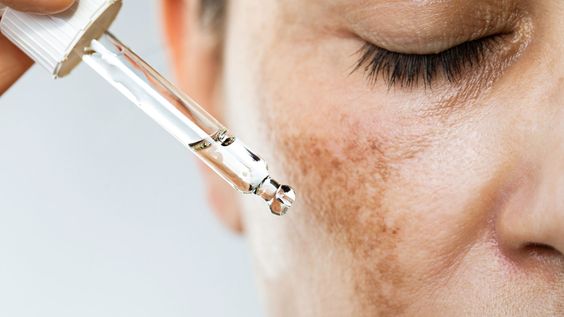Introduction
Have you ever noticed dark spots appearing on your skin, especially after spending time in the sun? You might be experiencing hyperpigmentation, a common skin condition that affects people of all ages and skin tones. Hyperpigmentation occurs when the skin produces excess melanin, the pigment responsible for our skin color. While generally harmless, these darker patches can be a cosmetic concern for some.

Sun-induced hyperpigmentation, also known as solar lentigines or age spots, is directly linked to prolonged sun exposure. When our skin is exposed to ultraviolet (UV) radiation from the sun, it triggers the production of melanin as a defense mechanism to protect itself from further damage. However, repeated or excessive exposure can overwhelm the skin's natural processes, leading to an uneven buildup of melanin and the formation of hyperpigmentation.
Understanding the Causes of Sun-Induced Hyperpigmentation
The primary culprit behind sun-induced hyperpigmentation is ultraviolet (UV) radiation. UVA and UVB rays penetrate the skin at different depths, both contributing to this condition. UVA rays are particularly insidious, penetrating deep into the dermis (the middle layer of skin) and causing long-term damage like wrinkles and age spots. UVB rays primarily affect the epidermis (the outer layer of skin) and are responsible for sunburns. Over time, both types of UV radiation can lead to melanin overproduction and the appearance of hyperpigmentation.
Several factors can influence your risk of developing sun-induced hyperpigmentation, including:
- Skin Tone: Individuals with darker skin tones are naturally more prone to hyperpigmentation because their skin produces more melanin.
- Sun Exposure: The more time you spend unprotected in the sun, the higher your risk of developing hyperpigmentation.
- Age: Sun-induced hyperpigmentation is more common as we age due to cumulative sun exposure over the years.
- Genetics: Some individuals are genetically predisposed to hyperpigmentation.
Recognizing Sun-Induced Hyperpigmentation
Sun-induced hyperpigmentation typically presents as flat, darkened patches of skin that can vary in size and shape. These spots are often brown, tan, or black and commonly appear on areas frequently exposed to the sun, such as:
- Face: Forehead, cheeks, nose, and upper lip
- Hands: Back of the hands and forearms
- Shoulders: Especially if frequently exposed to the sun
- Chest and Back: Areas often exposed to sun during outdoor activities
Preventing Sun-Induced Hyperpigmentation
Prevention is crucial in managing sun-induced hyperpigmentation. Here are some essential tips:
- Sun Protection is Key: Apply a broad-spectrum sunscreen with an SPF of 30 or higher daily, even on cloudy days. Reapply every two hours, especially after swimming or sweating.
- Seek Shade: Limit your exposure to direct sunlight, especially between 10 am and 4 pm when the sun's rays are strongest.
- Protective Clothing: Wear protective clothing, such as wide-brimmed hats, sunglasses, and long-sleeved shirts and pants, when spending time outdoors.
- Be Mindful of Medications: Certain medications can increase your skin's sensitivity to the sun, making you more susceptible to hyperpigmentation. Consult your doctor about potential photosensitivity risks.
Conclusion
Sun-induced hyperpigmentation is a common skin condition that can be effectively managed with proper sun protection and care. By understanding the causes and taking preventative measures, you can help maintain an even skin tone and minimize the appearance of dark spots. Remember, it's never too late to start protecting your skin!





